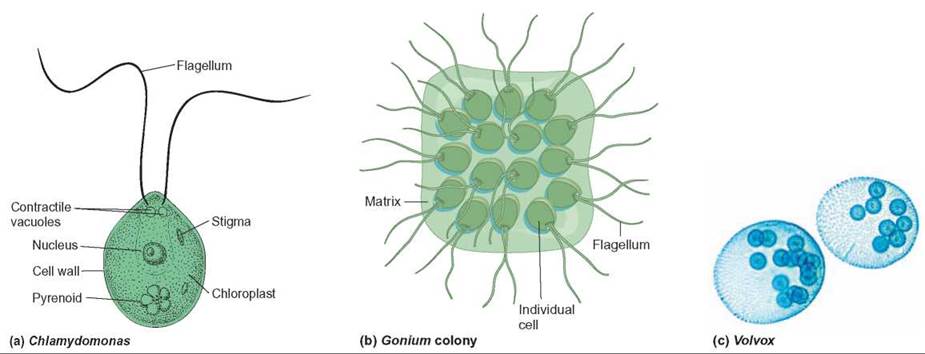CONCEPTS IN BIOLOGY
PART V. THE ORIGIN AND CLASSIFICATION OF LIFE
21. The Nature of Microorganisms
21.4. Multicellularity in the Protista
The three major types of organisms in the kingdom Protista (algae, protozoa, and funguslike protists) include both single- celled and multicellular forms. Biologists believe that there has been a similar type of evolution in all three of these groups. The most primitive organisms in each group are thought to have been single-celled and to have given rise to the more advanced, multicellular forms. Most protozoan organisms are single-celled however, some ciliates are colonial. The multicellular forms of funguslike protists are the slime molds, which have both single-celled and multicellular stages.
Perhaps the most widely known example of this trend from a single-celled to a multicellular condition is found in the green algae. A very common single-celled green alga is Chlamydomonas, which has a cell wall and two flagella. It looks just like the individual cells of the colonial green algae Volvox. Some species of Volvox have as many as 50,000 cells (figure 21.17). All the flagella of each cell in the colony move in unison, allowing the colony to move in one direction. In some Volvox species, certain cells have even specialized to produce sperm or eggs. Biologists believe that the division of labor seen in colonial protists represents the beginning of the specialization that led to the development of true multicellular organisms with many kinds of specialized cells. Three types of multicellular organisms—fungi, plants, and animals—eventually developed.

FIGURE 21.17. The Development of Multicellular Green Algae
(a) Chlamydomonas is a green, single-celled alga containing the same type of chlorophyll as that found in green plants. (b) Gonium, a green alga similar to Chlamydomonas, forms colonies composed of 4 to 32 cells that are essentially the same as Chlamydomonas. (c) Volvox is a colonial green alga that produces daughter colonies and also has specialized cells that produce eggs and sperm.
21.4. CONCEPT REVIEW
21. Why do biologists think that the ancestors of plants, animals, and fungi could have been Protista?